

Included on this site are the following areas of the villa: page 1: the Pecile and the Heliocaminus Bath page 2: areas of or near the Imperial Palace, including the Building with Doric Pillars page 3: Maritime Theater page 4: Philosophers' Chamber and Greek and Roman Libraries page 5: Piazza d'Oro page 6: Building with Fishpond and Large Baths page 7: Praetorium, Small Baths and Vestibule, Nymphaeum with three Exedra page 8: the Canopus page 9: the Serapeum and the Temple of Venus | ||
The CanopusBuilt in a narrow valley, this area was designed to recall the Canopus canal, an arm of the Nile River between Alexandria and Abukir. Canopus was a port city on the Nile delta with a world-famous temple dedicated to Serapis. | ||
Looking toward the SerapeumThis area may have been used as a summer banqueting hall with less important guests arranged along the sides of the Canopus. See the Serapeum at the far end (south) of the Canopus. |
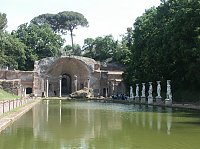
|
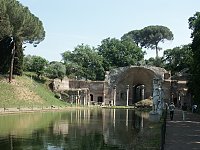
|
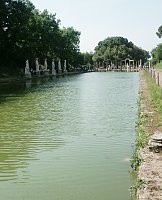
|
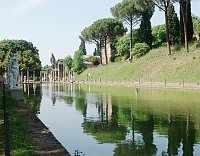
|
Looking toward the ExedraA number of statues, mostly copies of Greek works (now copies in cement while the original copies reside inside) decorated the perimeter. |
The Carytids, copies of the Korai from the Erechtheon on the Athenian AcropolisThese female figures were flanked by silenus figures, who hold baskets on their heads, with the basket replacing a capital. (One Silenus has lost his basket and both have lost their arms!) Some scholars speculate that the carytids and Silenus figures once supported a pergola that was beautifully reflected in the water. | ||
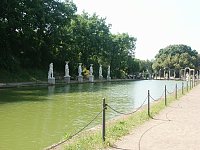
|
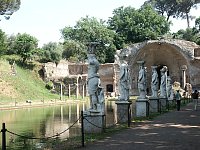
|
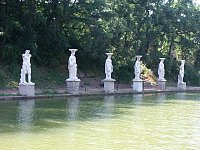
|
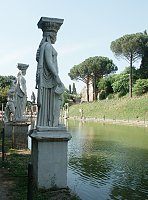
|
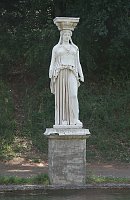
|
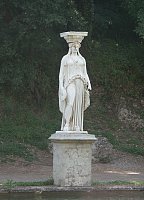
|
The Semicircular end with statuary--the so-called Ares and two Wounded Amazons--all copies of Greek originalsThis colonnade has alternating lintels and arches. This curvilinear portico is sometimes called "baroque" because of this stylistic exuberance. | ||
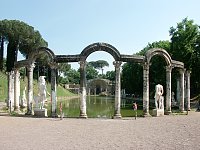
|
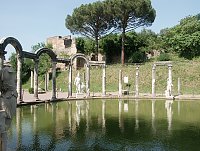
|

|
| Center: Wearing a tall helmet, this figure has been identified as Ares, although Adembri identifies him as Hermes,"recognized by the caduceus, a typical attribute of the god, traces of which are apparent on his right arm" (88). The other Wounded Amazon is a copy of the Greek original by Polyclitus. | 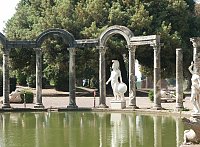
|
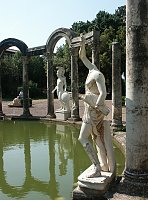
|
Front and rear views of a copy of the Wounded Amazon by Phidias for the Temple of Artemis at Ephesus | ||
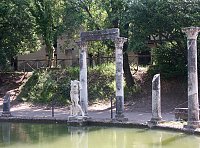
|
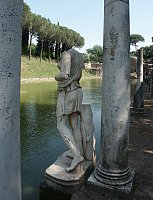
|
According to Adembri, this is "the most complete copy known to us from the ancient world and although it is not entirely preserved, [it] has allowed researchers to reconstruct a composite sketch of the Greek original: conceived as a standing figure who leans upon a spear, in order to compensate for her weakness caused by a wounded leg" (89). |
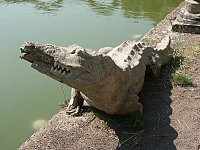
|
The crocodile, originally in cipollino marble, which is veined in a way suggesting the animal's hideOther sculpture around the Canopus include personifications of the Nile and Tiber, one a sphinx and the other the she-wolf with Romulus and Remus. This crocodile was probably part of a fountain since lead pipe was found between his jaws. Other sculptures discovered here are now in museums throughout Italy and Europe. | |
 Click here to return to index of art historical sites.
Click here to return to index of art historical sites.
 Click here to return to index of artists and architects.
Click here to return to index of artists and architects.
 Click here to return to chronological index.
Click here to return to chronological index.
 Click here to see the home page of Bluffton University.
Click here to see the home page of Bluffton University.
